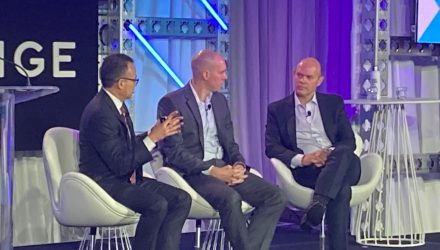It may have been a clever bit of media branding, but few can deny the impact the so-called “Magnificent Seven” had on markets last year. The group, comprising big names like Apple (AAPL) and Nvidia (NVDA), contributed about 60% of the S&P 500’s gains in 2023. The big question for investors, then, is whether that can continue and, if not, where to invest instead.
See more: “Active ETFs Gaining Popularity vs. Mutual Funds“
Looking outside of the Magnificent Seven was the topic of the “Beyond the Magnificent Seven” panel at the ETF Exchange conference last week. The panel, hosted by Freedom Investment Management CIO Ben Lavine, included both T. Rowe Price Head of Global Investments, CIO Eric Veiel, and Parametric Managing Director – Investment Strategy Alex Zweber, sharing their thoughts on the big seven.
Introduced by Lavine, Veiel started by putting the Magnificent Seven in a historical context. He set out to compare the seven to other big groups like the early 2000s tech bubble and the so-called “Nifty 50.”
Assessing factors like valuation and market weight, his graphs showed that while the Magnificent Seven have the highest weight relative to the market, they are less expensive based on 24-month forward P/E value and forward EV/sales than a combined list of Microsoft (MSFT), Cisco Systems (CSCO), Intel (INTC), Oracle (ORCL), IBM (IBM), Lucent, and Nortel Networks during that tech bubble.
“So currently, the big tech average is at 24 times a little over the forward two-year earnings P/E estimate versus nearly 52 times back in the tech bubble,” Veiel said. “The overall quality and growth prospects of these companies versus other points in time is notably different.”
Understanding the Magnificent Seven
Noting that, however, Veiel explained that at T. Rowe Price, the firm’s fundamental perspective doesn’t look at the firms as one big bloc. Instead, it considers each on its own.
“Sometimes people try to weave an AI theme through all of them, which to some extent, you can, but we don’t think that’s the right way. We are very much bottoms up in reviewing each of these stocks,” Veiel said.
For example, on the one hand, Veiel pointed out that NVDA and Amazon (AMZN) had great years. NVDA, for example, had 411% earnings growth and 239% stock price performance. That saw its multiple contract by 34%, he said. Tesla (TSLA), by contrast, was up 102% in 2023, with forward earnings estimates contracting 33%, expanding its P/E multiple by 200%.
“Our view is that these are not one homogenous group,” Veiel said. “We have individual work being done on each one of those stocks to get them right within our different portfolios. That is sort of the heart of what we’re doing with our 900 research analysts and investment professionals globally, performing 14,000 due diligence meetings to try to get to that.”
So, how might investors want to look forward beyond the Magnificent Seven? Veiel looked at whether the interest rate environment would point to a growth or value approach. Taken together, per the below graph, while growth and value do well in low to high-rate environments as measured by the 10-year Treasury, the current environment sits in about the middle at 3 to 5%, in which neither approach significantly outdoes the other historically.
Small and Mid Cap ETFs
While a value approach could still be worth considering given the balance it can add to just how dominant growth has become in the S&P 500, he said, his focus turned towards small and mid-cap indices. Veiel emphasized how potential improvements to capital markets could boost small and midcaps, which currently offer attractive valuations, for example.
“There’s also a fundamental reason that I think small and mid have underperformed over this period, really starting back in late 2020 through 2023, that could reverse,” he said. “It’s one that I don’t get a lot of people talking about, but capital markets activity has largely slowed down in a very profound way in this area,” Veiel said.
“When that happens, small and mid-cap stocks have had fewer M&A opportunities, where they tend to be the targets (and) tend to do better.”
Based on that take, then, Veiel pointed to a few ETFs from T. Rowe Price that could appeal. For example, the T. Rowe Price Small-Mid Cap (TMSL) could provide an option to lean on active investing to identify small and mid-cap firms with strong fundamentals. The T. Rowe Price Capital Appreciation Equity ETF (TCAF), managed by David Giroux, also offers an appealing long-term, fundamentally focused active ETF that looks to large caps.
For more news, information, and analysis, visit the Active ETF Channel.








